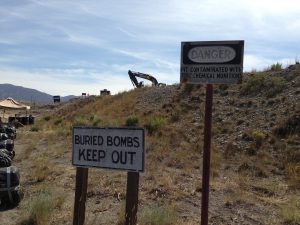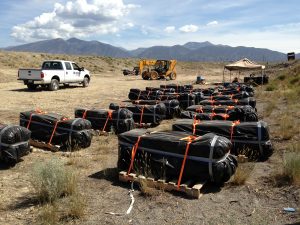Tooele Army Depot-South Remediation (Deseret Chemical Depot)

KEMRON completed a CR TO under the Huntsville Worldwide Environmental Remediation Services (WERS) Multiple Award Task Order Contract (MATOC). The performance objective was to achieve Response Complete at Solid Waste Management Unit (SWMU) 2 at the Deseret Chemical Depot in Stockton, UT (now known as Tooele Army Depot-South). SWMU 2 was an area contaminated with discarded military munitions (DMMs) and possible chemical weapons munitions (CWMs) and other military devices as well as a suspected burial trench containing both DMM and CWM. KEMRON completed the removal of contaminated soils, material potentially presenting an explosive hazard (MPPEH), and disposition of all recovered material through disposal or destruction. Final confirmatory sampling confirmed Response Complete.
SWMU 2, a 10-acre parcel in the southwest portion of the Chemical Munitions Storage Area at Deseret, was historically used for the disposal of munition-related items to include conventional weapons as well as suspected mustard agents and other chemical munitions. KEMRON collaborated with the Edgewood Chemical and Biological Center (ECBC) and Chemical, Biological, Radiological or Nuclear Analytical and Remediation Activities (CARA) to provide field support for safety during intrusive and removal action activities. KEMRON prepared the work plan for this removal action, an APP, a Chemical Safety Submission (CSS) to the Department of Defense Explosives Safety Board (DDESB).

Digital geophysical mapping (DGM) techniques were employed to identify single point anomalies as well as the location of the suspected burial pit and delineate the boundaries of this disposal area. Prior to any intrusive activity, the KEMRON team underwent pre-operational training and drills with oversight and approval by Edgewood Chemical and Biological Center (ECBC) and CARA. Emergency personnel and evacuation equipment were present at all times during this removal action.
The disposal trench defined during the DGM study covered an area of approximately 50 ft by 300 ft. Fifteen ft of overburden was removed from the trench prior to encountering DMM. Once the overburden was removed, KEMRON recovered 112,243 Atlas squibs, 704 E46 cluster bomb units (CBUs) 1,448 M1 and M4 Smoke Pots, 2,589 M2 Smoke Candles, 640 M6 CN/DM grenades, and an assortment of fuses and boosters. All DMM was carefully removed, repackaged, and stored in existing bunkers to await final disposal. Contaminated soil recovered during this removal action was stockpiled and segregated pending final disposition. Contaminated soil (5,000 yards) was transported off-site for disposal at a Subtitle D disposal facility. Thermal destruction of the smoke pots, grenades, and candles was originally proposed as an on-site operation but the presence of chemical agents (arsenic) and stringent air discharge criteria ultimately precluded this process. These units were packaged and transported to a licensed incinerator for final disposal. The CBUs were destroyed on-site. KEMRON designed a burn chamber consisting of an open top 20-yd3 container. A flex liner shape charge (FLSC) was attached to each CBU to open the unit and facilitate burning. The CBU was packed in dunnage along with an ignitor and smokeless powder. The shape charge and squib were ignited simultaneously to initiate the burn unit and subsequent CBU detonation. 704 CBUs were destroyed in a system of eight burn chambers.
Confirmation sampling in order to achieve Response Complete included surface soil samples, wall and floor samples from the disposal pit, direct push technology soil boring for subsurface sample retrieval and field test equipment including PIDs for organics, x-ray fluorescence (XRF) for metals and Miniature Continuous Air Monitoring Systems (MINICAMS) for CWM. In-field screening and segregation of recovered soil resulted in the identification of over 3,000 yards of soil that could be used as backfill.
Air modeling was conducted in support of the proposed thermal destruction of the smoke pots, grenades, and candles. The air modeling was completed in accordance with Utah Division of Air Quality (UDAQ) Rule R307-410 and EPA Guidelines on Air Quality Models addressing air emissions associated with the use of burn pans and open detonation. The results of the modeling effort provided quantification of the amount of munitions that could be detonated and burned on-site.A conceptual site model (CSM) and associated data quality objectives (DQOs) were developed to support the conclusion of Response Complete identifying sources, media, pathways, receptors, COCs, analytical methods, and risk-based decision points. EPA RSLs and site-specific soil to groundwater values were derived to establish attenuation factors. This risk-based approach reduced the volume of soil requiring disposal by over 50%.
A large part of this contract is for the on-site burn operations designed for the destruction of more than 750 CBUs. Due to safety concerns, it was necessary to move all personnel away from the burn pans to a distance of more than 800 ft which prevented monitoring of the operation. KEMRON worked with the installation to obtain permission to use a drone to fly over the burn pans and video the operation. This allowed USACE, the installation, and KEMRON to evaluate all aspects of the burn without compromise to safety.